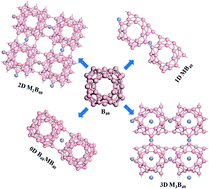Low-dimensional functional networks of cage-like B40 with effective transition-metal intercalations†
Abstract
As the first all-boron fullerene observed in experiments, cage-like borospherene B40 has attracted considerable attention in recent years. However, B40 has been proved to be chemically reactive and tends to coalesce with one another via the formation of covalent bonds. We explore herein the possibility of low-dimensional functional networks of B40 with effective transition-metal intercalations. We find that the four equivalent B7 heptagons on the waist of each B40 can serve as effective ligands to coordinate various transition metal centers in exohedral motifs. The intercalated metal atoms entail these networks with a variety of intriguing properties. The two-dimensional (2D) Cr2B40 network is a ferromagnetic metal while the 2D Zn2B40 network becomes semiconducting. In contrast, other 2D M2B40 (M = Sc, Ti, V, Mn, Fe, Co, Ni and Cu) networks and 1D CrB40 belong to nonmagnetic metals. The 3D Cr3B40 network is a magnetic metal. This work presents the viable possibility of assembling Mn&B40 metalloborospherenes into stable functional nanomaterials via effective transition-metal intercalations with potential applications in electronic and spintronic devices.



 Please wait while we load your content...
Please wait while we load your content...